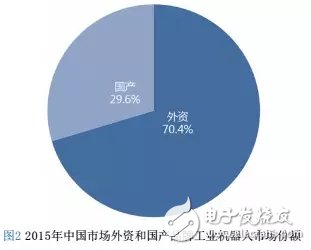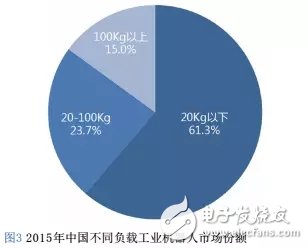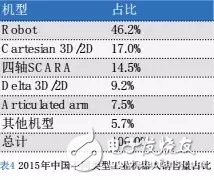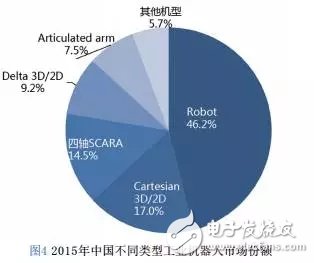1, the classification of robots
For the classification of robots, there is no uniform standard in the world, which can be classified according to the application field, use, structure form, degree of freedom, load and control method.
According to different application fields, there are currently two types of robots in China, namely industrial robots and special robots. According to the characteristics of the current industrial market, this report focuses on the Chinese industrial robot market.
Industrial robots, ie multi-joint robots or multi-degree-of-freedom robots for the industrial sector.
According to the purpose, industrial robots can be divided into welding robots, handling robots, painting robots, rubberizing robots, assembly robots, palletizing robots, cutting robots, automatic guided vehicles (AGV) robots, and clean room robots.
According to the structural form, industrial robots can be divided into three types: Cartesian coordinates, cylindrical coordinate robots and articulated robots. The joint industrial robots are mainly 4-6 axes.
According to the load, industrial robots can be divided into small load robots (loads less than 20Kg), medium load robots (loads between 20~100Kg) and large load robots (loads greater than 100Kg).
Special robots are advanced robots other than industrial robots that are used for non-manufacturing and serve humans. Including: service robots, underwater robots, entertainment robots, military robots, agricultural robots, robotic machines, etc. In special robots, some branches develop rapidly and have independent institutional trends, such as service robots, underwater robots, military robots, and micro-manipulation robots.

2, the basic composition of the robot
Industrial robots consist of three basic parts: the main body, the drive system and the control system. The main body is the base and the actuator, including the arm, the wrist and the hand, and some robots and walking mechanisms. Most industrial robots have 3-6 degrees of freedom of movement, of which the wrist usually has 1-3 degrees of freedom of motion; the drive system includes a power unit and a transmission mechanism to cause the actuator to act accordingly; the control system is input according to the input The program signals and controls the drive system and the actuator.
Development of the robot industry
China has become the world's largest demander of industrial robots. The market is developing steadily. The manufacture of automobiles and their parts and components is still the main application field of industrial robots. With the continuous adjustment and upgrading of China's industrial structure and the transfer of international manufacturing centers to China. China's robot market will further increase, and the speed of market expansion will be further improved.
1. Development status of industrial robots
The rise in labor prices in China has pushed up production costs and is considered to be one of the reasons why industrial robots are rapidly entering production. Since January 1, 2008, since the implementation of the new labor law, the minimum wage level has been raised in various parts of China. The labor costs in coastal areas have been rising steadily, and the shortage of migrant workers has occurred. The Chinese population dividend has gradually lost, and some production enterprises have begun to move out. And in recent years, China's robotic automated production lines have emerged, the most typical of which is the automotive and electronics industries. With the continuous improvement of the automation level of Chinese industrial enterprises, the market of robotic automation lines will become larger and larger, and gradually become the main way of automated production lines.
According to a survey conducted by Rui Industry in 2016, China's industrial robot market in 2015, with six-axis multi-joint robots as the most, accounted for 46.2% of total sales. It is expected to maintain a high growth rate of more than 30% in the next few years. The market for robotic automated production line equipment in China has just started, and the domestic equipment manufacturing industry is in the period of transition from traditional equipment to advanced manufacturing equipment, which brings huge business opportunities to robotic automated production line research and development. Manual replacement and industrial upgrading are considered to be the driving factors for the rapid development of China's industrial robot market. At the same time, China's current robot density (the number of robots per 10,000 production workers) is relatively low, which also provides a future market development. room.
2. Application fields of industrial robots
After more than forty years of development, industrial robots have been applied in more and more fields. Industrial robots have been widely used in manufacturing, especially in the automotive industry. For example, in the manufacturing of blanks (stamping, die-casting, forging, etc.), machining, welding, heat treatment, surface coating, loading and unloading, assembly, inspection and warehouse stacking, robots have gradually replaced manual operations.
With the development of industrial robots in a deeper and broader direction and the improvement of the level of robot intelligence, the application cycle of robots is still expanding, and has been promoted from the automobile manufacturing industry to other manufacturing industries, and then promoted to such as mining robots and construction industry. Various non-manufacturing industries such as robots and hydropower systems maintenance and repair robots. In addition, there are more and more applications of robots in the fields of national defense, military, medical and life services, such as unmanned reconnaissance aircraft (aircraft), police robots, medical robots, and housekeeping service robots. Robots are playing an important role in improving the quality of human life.
Industrial market analysis of industrial robots
1. The scale and growth trend of China's industrial robot market
In 2015, the overall growth rate of China's industrial robot market was relatively optimistic, with sales reaching 82,495 units, a year-on-year increase of 39.6%, and sales reaching 12.82 billion yuan, a year-on-year increase of 37.3%. Under the trend of slow growth in macroeconomics and manufacturing, China's industrial robot market continues to grow at a rate of more than 30%. In view of the huge space for industrial robot replacement, it is expected that the industrial robot market in China will maintain a high growth trend in the next few years.


2. Market analysis of domestic brands and foreign-invested industrial robots
In 2015, the market performance of foreign-branded industrial robots was much better than that of domestic brands. The sales volume of foreign brands accounted for 70.4%, and the sales volume of domestic brands accounted for 29.6%. The domestic brand industrial robots are mainly Cartesian3D/2D, ArTIculatedarm and Delta3D/2D, and the price is lower. Compared with foreign brands, domestic brand robots have much room for improvement in terms of sales volume, sales volume and product quality.

3. Analysis of China's different load industrial robot market
From the load point of view, among the industrial robots sold in China in 2015, small-load industrial robots are mainly used, and medium-sized loads and large-load industrial robots are relatively few. For smaller load robots, medium and large load robots, especially large load robots, are mainly used for handling large objects, and the demand is much smaller than that of small load robots with lower application prices.

4. Analysis of different types of industrial robots in China
In terms of models, in the industrial robots sold in China in 2015, Robot and Cartesian3D/2D were the mainstays. Robot sales accounted for 46.2%, and Cartesian3D/2D sales accounted for 17.0%. And reached 63.2% of the total sales. The main reason for the largest sales volume of Robots is that they are mainly used in the automotive field, and the automotive field is the most mature field of robot applications. Cartesian3D/2D is mainly used in the fields of plastics rubber and metal processing. In addition to the lower price, Cartesian3D/2D has become the market share second only to Robot.

For the classification of robots, there is no uniform standard in the world, which can be classified according to the application field, use, structure form, degree of freedom, load and control method.

It is suitable for the computers.inspection appliance and instruments with rated voltage up to 300/500V. This product presents an excellent performance in high
frequency locations
Instrument Cable,Moving Rubber Cable,Cpe Sheath Flexible Cable,Outer Moving Cable
Baosheng Science&Technology Innovation Co.,Ltd , https://www.bscables.com
